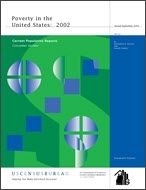Poverty in the United States: 2002
Poverty in the United States: 2002
Introduction
Poverty data offer an important way to evaluate the nation's economic well-being. This report illustrates how the official poverty rates vary by selected characteristics — age, race and Hispanic origin, nativity, family composition, work experience, and geography. These data show how many people were in poverty in 2002 and how the poverty population has changed. A description of how the Census Bureau measures poverty may be found on page 4. Because the poverty population in the United States is too diverse to be characterized along any one dimension, the report also includes several alternative ways of measuring poverty, and is accompanied by a separate report, Supplemental Measures of Material Well-Being: Expenditures, Consumption, and Poverty: 1998 and 2001 (P23-201).
Highlights
The data presented here are from the Current Population Survey (CPS), 2003 Annual Social & Economic Supplement (ASEC), the source of official poverty estimates. The CPS ASEC is a sample survey of approximately 78,000 households nationwide. These data reflect conditions in calendar year 2002.
- The official poverty rate in 2002 was 12.1 percent, up from 11.7 percent in 2001.
- In 2002, people below the official poverty thresholds numbered 34.6 million, a figure 1.7 million higher than the 32.9 million in poverty in 2001.
- At 16.7 percent, the poverty rate for children did not change between 2001 and 2002, but remained higher than that of 18-to-64-year-olds and seniors aged 65 and over. However, the number of children in poverty increased to 12.1 million in 2002, up from 11.7 million in 2001.
- For people 18 to 64 years old, both the number in poverty and the poverty rate rose from 2001 to 2002–from 17.8 million to 18.9 million, and from 10.1 percent to 10.6 percent, respectively. Similarly, the number of elderly in poverty increased from 3.4 million in 2001 to 3.6 million in 2002, though their poverty rate remained unchanged at 10.4 percent.1
- Because racial and ethnic categories were redefined in 2002, no single comparison of poverty rates by race between 2001 and 2002 meets all needs. However, using a variety of definitions for the race categories for 2002.
- The poverty rates in 2002 for non-Hispanic Whites (8.0 percent for those who identified with no other race groups) and Asians (10.0 percent to 10.3 percent, depending on the race definition) were not different from the rates for the closest groups available in 2001.2
- Among people who reported Black in 2002, 23.9 percent to 24.1 percent were in poverty, depending on the race definition. Both figures were higher than the 22.7 percent for those who reported Black in 2001.
- For Hispanics (who may be of any race), the poverty rate was 21.8 percent in 2002, unchanged from 2001.3
- In 2002, 7.2 million families (9.6 percent) were in poverty, up from 6.8 million (9.2 percent) in 2001.
- For married-couple families, the number in poverty and the poverty rate rose from 2001 to 2002–from 2.8 million to 3.1 million, and from 4.9 percent to 5.3 percent, respectively.
- The number of female householder families with no husband present in poverty increased to 3.6 million in 2002 from 3.5 million in 2001. The poverty rate for these families was unchanged from 2001, at 26.5 percent.
- The poverty rate in the Midwest increased from 9.4 percent in 2001 to 10.3 percent in 2002. The poverty rates in the Northeast, South, and West did not change.
- The number in poverty and the poverty rate for people living in the suburbs rose from 12.1 million and 8.2 percent in 2001 to 13.3 million and 8.9 percent in 2002; neither the number in poverty nor the poverty rate changed in central cities or outside metropolitan areas.
__________
1 The poverty rate for people aged 65 and over was statistically indistinguishable from the rate for 18-to-64-year-olds. Because the poverty rates in this report are estimates, two groups that appear to have different poverty rates may not truly have different rates from one another.
2 The poverty rates for the various racial subgroups that include Asians (ranging from 10.1 to 10.3 percent) were not statistically distinguishable from one another.
3 Because Hispanics may be of any race, data in this report for Hispanics overlap slightly with data for the Black population and for the Asian population. Based on the 2003 Current Population Survey Annual Social and Economic Supplement (CPS ASEC), 3.5 percent of Blacks who reported only one race and 1.6 percent of Asians who reported only one race were of Hispanic origin. For the poverty population, Hispanics made up 4.0 percent of Blacks (single race) and 1.6 percent of Asians (single race). Despite the sample expansion, single-year data for the American Indian and Alaska Native population and the Native Hawaiian and Other Pacific Islander population are not shown in this report because of their small sample sizes in the 2003 CPS ASEC. Data users should exercise caution when interpreting aggregate results for both the Hispanic population and the Asian population because they consist of many distinct groups that differ in socio-economic characteristics, culture, and recency of immigration. In addition, the CPS does not use separate population controls for weighting the Asian sample to national totals. For further information, see www.bls.census.gov/cps/ads/adsmain.htm.
Tables
Poverty by Definition of Income (R & D)
Charts
Graphs
Poverty by Definition of Income (R & D)
Press Briefing
Historical Tables
Table
Table
Table
Source Information
Others in Series
Visualization
Publication
Publication









